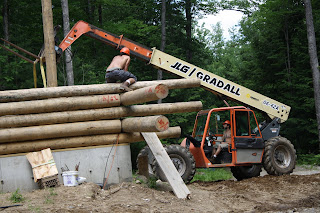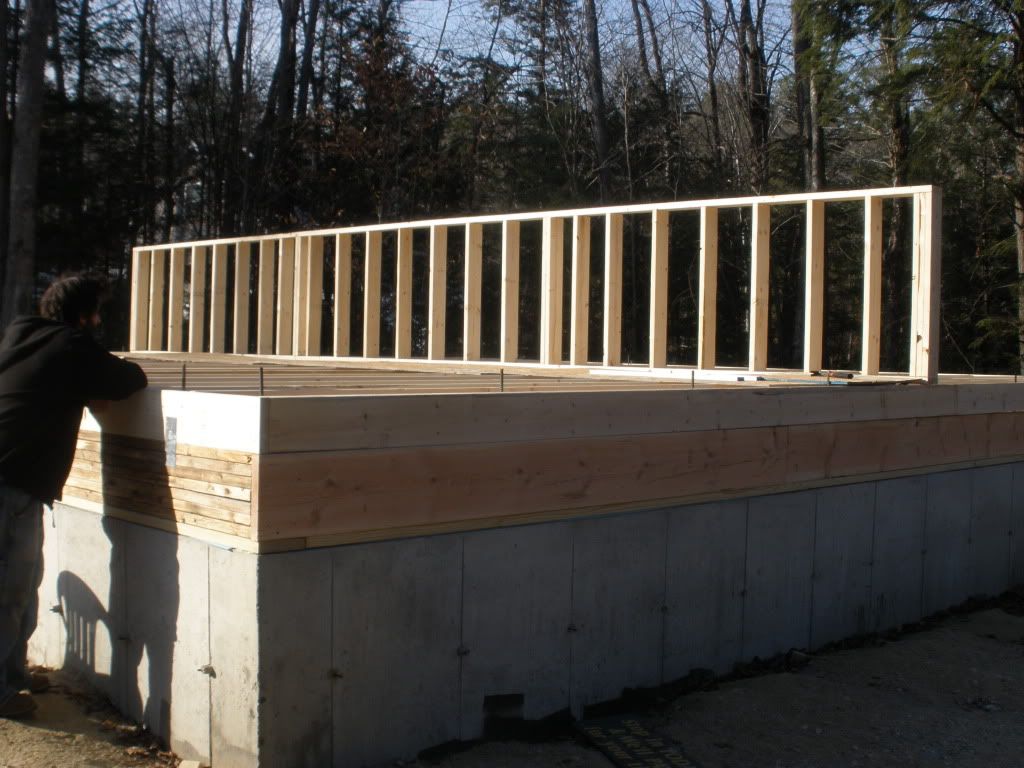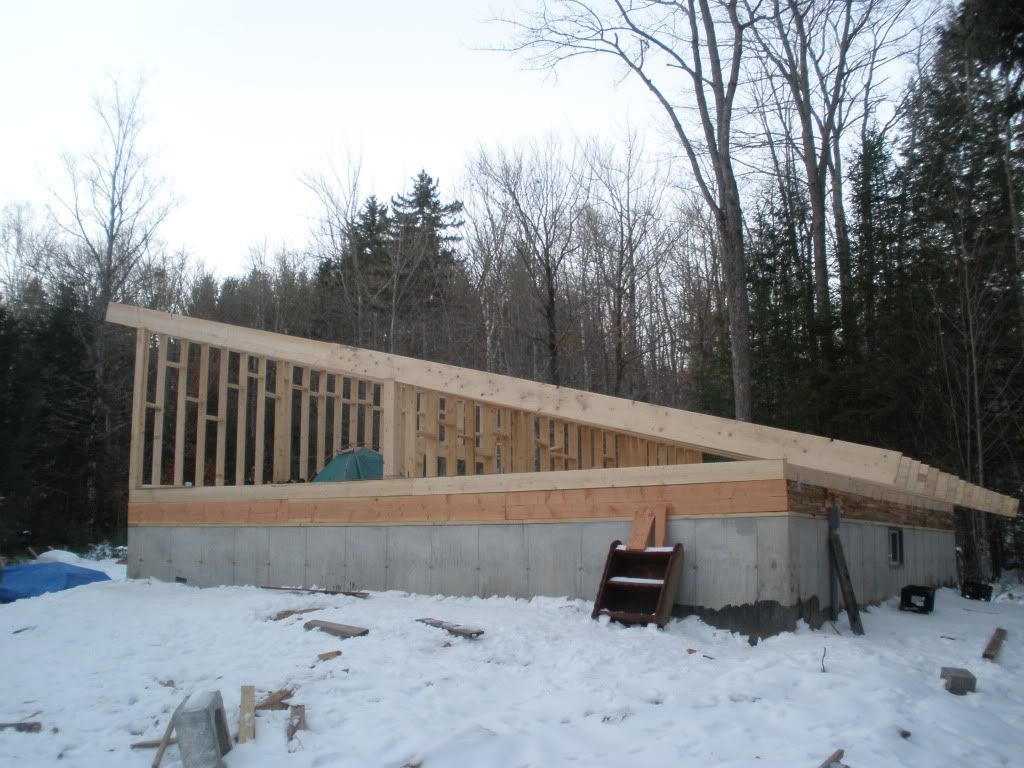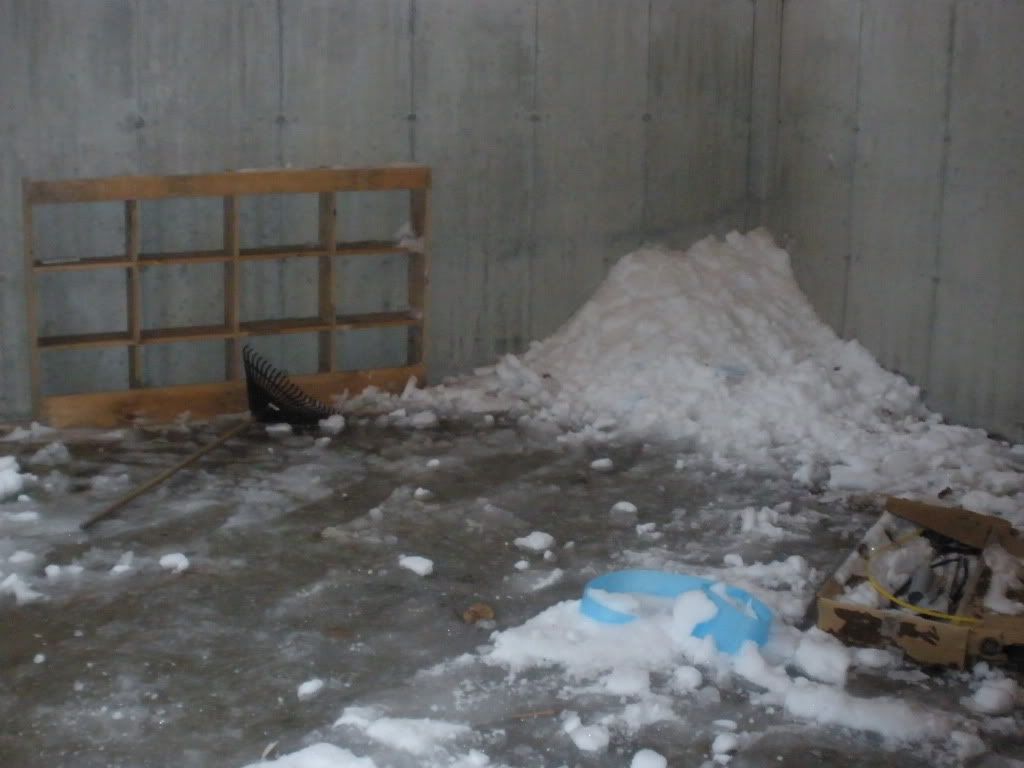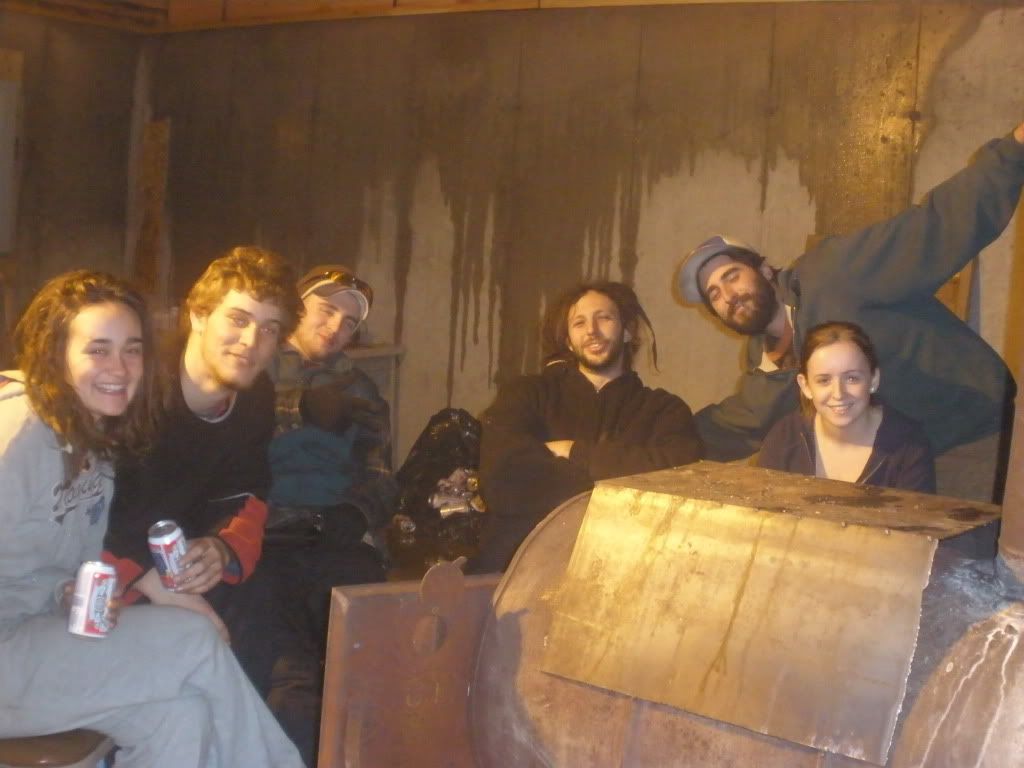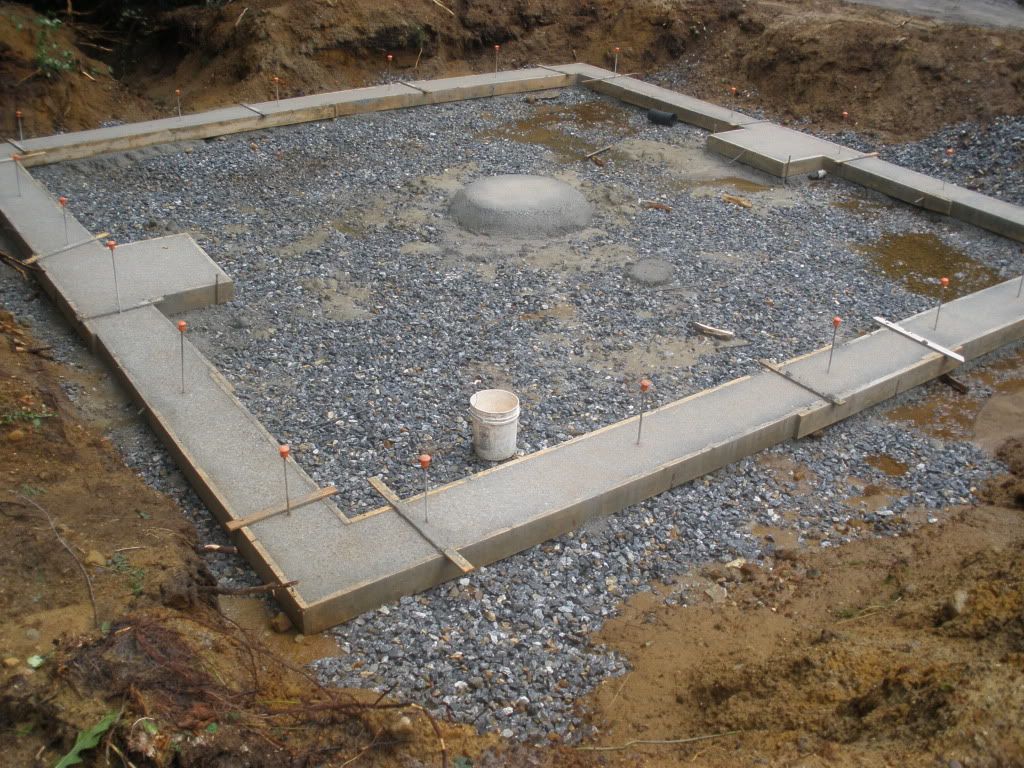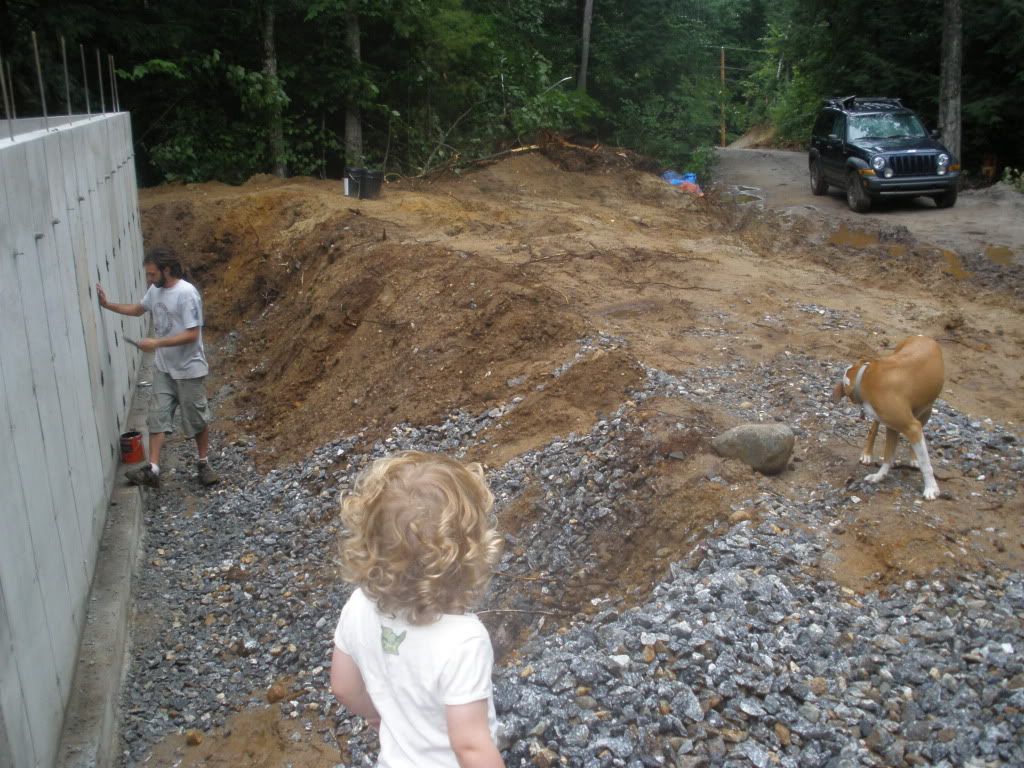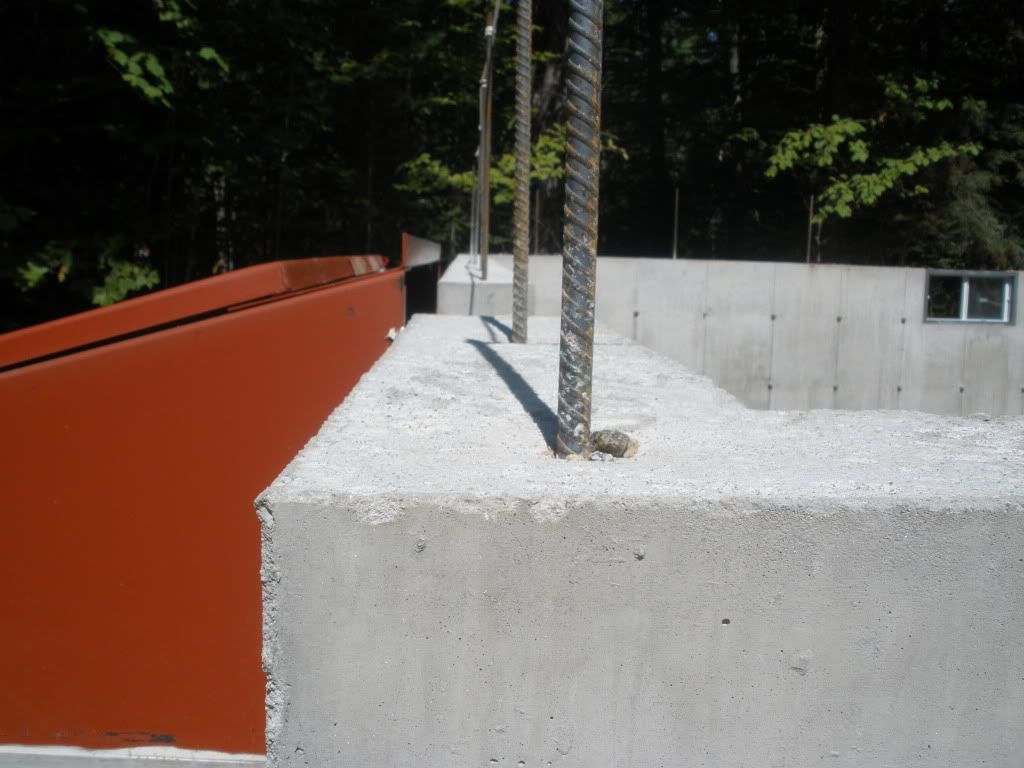Back to work after a long weekend off for the 4th of July. We've got 11 courses of logs up, and we're about to put up our second floor girders in. After the girders go in, we'll probably put up another 3 courses of logs before moving on to our ridge pole. Lifting logs to this height has started to get a bit dangerous, so we chose to have a steeper pitched roof with shorter walls than we had originally planned for. We're hoping to have our extra logs milled into dimension lumber and/or floorboards, but if that doesn't work out we'll save them for the next house.
Here's Steve driving the telehandler while Angelo holds a rope tied to the end of the log. The added stability from this is huge.
Angelo is on the wall in the foreground, helping to guide in the log. Steve is in the machine doing the heavy lifting.
Our friend Jedd came up for 10 days and helped out. In this picture Steve and Jedd are standing on scaffolding we made out of 2x12s resting on top of saw horses. Steve is on the right pre-drilling holes through the top log. Jedd then takes a piece of 1/2" rebar and hammers it into the log below.
From left to right we have Angelo, Steve, and our neighbor, Dave. In this shot we're reading the log to see which way it might bow in order to decide how it could sit once we put it on the wall.
Our progress so far. 1 log shy of 11 courses. The second floor girders will go in soon, then only a few more courses before we start focusing on the roof.
Bob Loblog's Log Blog
Wednesday, July 6, 2011
Wednesday, June 22, 2011
First floor joists
Once our RPSLs were up we got right to putting in our first floor and some rough decking. This was important for safety and allowed us to put up some scaffolding for easier access to our walls.
Our friend Russ came to help out for the afternoon when we set our ledger boards. We set these 2x8s along the log walls and made sure they were level.
Once our ledger boards were all in place, we bolted them in with pairs of 1/2" x 6" lag bolts every 2' along each board. We were able to plumb these ledgers by tightening or loosening either the top or the bottom bolt.
With the ledgers were properly secured, we hung joist hangers on them and started laying down our floor joists. To level our floor joists, we decided to shim them where they rest on the girder. Doing this instead of notching the girder seemed easier to us.
All the joists up and we were able to put down some rough decking. This plywood now goes about 8' in around all 4 walls.
Our friend Russ came to help out for the afternoon when we set our ledger boards. We set these 2x8s along the log walls and made sure they were level.
Once our ledger boards were all in place, we bolted them in with pairs of 1/2" x 6" lag bolts every 2' along each board. We were able to plumb these ledgers by tightening or loosening either the top or the bottom bolt.
With the ledgers were properly secured, we hung joist hangers on them and started laying down our floor joists. To level our floor joists, we decided to shim them where they rest on the girder. Doing this instead of notching the girder seemed easier to us.
All the joists up and we were able to put down some rough decking. This plywood now goes about 8' in around all 4 walls.
Monday, June 20, 2011
Ridge Pole Support Logs Up!
Yesterday we lifted our first Ridge Pole Support Log (RPSL), and lifted the other two today. These logs go directly up from the basement to hold up the Ridge Pole at the center of our roof. Normally people put these logs up last, but we chose to put them in early so we could put up our first floor sooner.
Here's Steve watching as Angelo set the first RPSL in place. We rested it between the south wall and the first floor girder.
Using the forklift to lift the first RPSL into place.
After about 2 hours of messing around with the machine, we got the first RPSL in place.
With the experience we got on the first day, the second RPSL went up in about an hour.
Before we knew it, the third RPSL was up. After each RPSL was in place, we drilled holes in our foundation to set brackets in place with anchor bolts. Then we drilled through the RPSL into the girder and held them in place with 1/2" x 6" lag bolts.
Here's Steve watching as Angelo set the first RPSL in place. We rested it between the south wall and the first floor girder.
Using the forklift to lift the first RPSL into place.
After about 2 hours of messing around with the machine, we got the first RPSL in place.
With the experience we got on the first day, the second RPSL went up in about an hour.
Before we knew it, the third RPSL was up. After each RPSL was in place, we drilled holes in our foundation to set brackets in place with anchor bolts. Then we drilled through the RPSL into the girder and held them in place with 1/2" x 6" lag bolts.
Saturday, June 11, 2011
1st log through the 15th
Dropped our first log May 22nd, 2011. Here's Angelo pounding the rebar to the side.
By May 26th we had two full courses and our first floor girder dropped. Here's Steve working the forklift to put the girder in place.
With our first floor joists resting on this girder, our basement ceilings are going to be about 10ft high. It'll be a huge open space with tons of exposed log.
The way we left the place about 2 weeks ago when we went on vacation.
Panoramic view from the inside. 3.5 courses up, many more to go.
After 2 weeks off, we're heading back up on Monday, June 13th. We'll be working non-stop for the next month after that, so expect some serious progress. We also just had internet installed on site, so we'll be able to do more frequent updates.
By May 26th we had two full courses and our first floor girder dropped. Here's Steve working the forklift to put the girder in place.
With our first floor joists resting on this girder, our basement ceilings are going to be about 10ft high. It'll be a huge open space with tons of exposed log.
The way we left the place about 2 weeks ago when we went on vacation.
Panoramic view from the inside. 3.5 courses up, many more to go.
After 2 weeks off, we're heading back up on Monday, June 13th. We'll be working non-stop for the next month after that, so expect some serious progress. We also just had internet installed on site, so we'll be able to do more frequent updates.
Friday, May 20, 2011
Telephone poles, telescoping forklift, and mud!
Got our logs delivered last week... 105 35ft and 4 45ft untreated telephone poles. Sweet!
Then we got our telehandler delivered. Capable of lifting 6,000lb 42ft in the air. Awesome 4 wheel drive system that allows us to drive sideways if we want to!
Then it rained.
We had our groundwork guy come buy with a load of crushed stone and his front end loader this morning. He pulled the lifter out in about 5 minutes and in 20 minutes more had our mud puddle turned into a semi-driveable surface. Time to get back to work.
Monday, December 1, 2008
Temporary roof for winter
After a long summer of trying to find log suppliers and dwindling money, we reluctantly had to cap off the roof until 2011 when we were financially able to get back to work.
Angelo looking across the floor joists to the first wall we put in. This would eventually be the mid-point of our shed roof covering the whole basement.
The bare frame of our shed roof. Along with the 2x12 roof rafters, the majority of the lumber used in this project will be salvaged to be used when building our log home.
No good pictures of the completed cap handy. Once the roof and walls were up, though, we had to scrape and shovel about 8" of snow and ice from the floor into the corner where the drain is.
Cap completion celebration party! We had to stay pretty close to the converted oil barrel that was our wood stove as it really didn't put out much heat and our walls/roof were completely uninsulated. Still, much fun was had by all.
Angelo looking across the floor joists to the first wall we put in. This would eventually be the mid-point of our shed roof covering the whole basement.
The bare frame of our shed roof. Along with the 2x12 roof rafters, the majority of the lumber used in this project will be salvaged to be used when building our log home.
No good pictures of the completed cap handy. Once the roof and walls were up, though, we had to scrape and shovel about 8" of snow and ice from the floor into the corner where the drain is.
Cap completion celebration party! We had to stay pretty close to the converted oil barrel that was our wood stove as it really didn't put out much heat and our walls/roof were completely uninsulated. Still, much fun was had by all.
Tuesday, July 1, 2008
Full basement is poured
Footings...
Wall forms are up and ready to be poured.
Steve helping seal the foundation before backfilling. 2 year old Ari in the foreground and Steve's dog, Dasia, to the right.
Rebar coming up out of foundation wall roughly every 4ft, and our bulkhead (aka bilco).
Wall forms are up and ready to be poured.
Steve helping seal the foundation before backfilling. 2 year old Ari in the foreground and Steve's dog, Dasia, to the right.
Rebar coming up out of foundation wall roughly every 4ft, and our bulkhead (aka bilco).
Subscribe to:
Comments (Atom)

